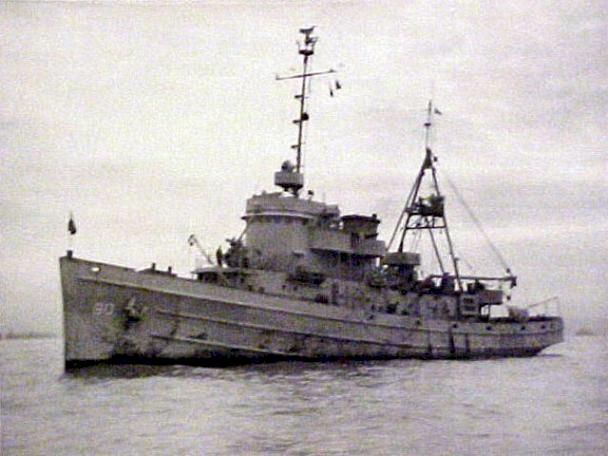Name USS Pinto Commissioned 1 April 1943 Reclassified ATF-90, 15 May 1944 Construction started 10 August 1942 Length 62 m | Laid down 10 August 1942 Decommissioned 11 July 1946 Struck 17 May 1974 Launched 5 January 1943 | |
 | ||
Builders William Cramp & Sons, Philadelphia | ||
Uss pinto at 90
USS Pinto (AT-90) was an Navajo-class fleet tug constructed for the United States Navy during World War II. Her purpose was to aid ships, usually by towing, on the high seas or in combat or post-combat areas, plus "other duties as assigned." She served in the Atlantic Ocean and, at war’s end, returned home proudly with three battle stars to her credit.
Contents
- Uss pinto at 90
- World War II Atlantic Ocean operations
- Normandy Invasion operations
- Invasion of Southern France operations
- Transferred to the Pacific Fleet
- Decommissioning
- Awards
- References
Pinto was laid down by the Cramp Shipbuilding Co. of Philadelphia 10 August 1942; launched 5 January 1943; sponsored by Miss Lorna Cook; and commissioned 1 April 1943; Lt. Ralph Brown in command.
World War II Atlantic Ocean operations
Following shakedown, Pinto served in Service Squadron 1, Service Force, Atlantic Fleet operating on the U.S. East Coast of the United States and at Argentia, Newfoundland until 15 December 1943 when she arrived Long Island Sound to conduct salvage and towing operations for the U.S. Army and Navy Proving Grounds, Davisville, Rhode Island.
Normandy Invasion operations
On 26 March 1944, Pinto was underway for the European theater of operations, arriving Falmouth, England on 19 April. She was redesignated ATF-90 on 15 May. She arrived off the Normandy invasion coast on 6 June, where she and two other tugs comprised Combat Salvage Unit 122.3.1 which assisted and made emergency repairs to invasion landing craft while under enemy fire. On "D-Day" plus one (7 June 1944), Susan B. Anthony (AP-72) struck a mine, and was left burning and in a sinking condition. Pinto aided in removing 2,200 Army troops plus the Navy crew, for which she received the Navy Unit Commendation. Pinto remained on station as combat salvage vessel off "Omaha Beach" until 3 July when she returned to England.
Invasion of Southern France operations
She arrived at Oran, Algeria, on 21 July, and joined the assault Force for "Operation Dragoon". On 15 August she arrived off the coast of southern France with task unit TU 85.14.7 and conducted salvage operations under enemy fire until 28 August when she returned to Oran and then the United States.
Transferred to the Pacific Fleet
On 10 November Pinto, with a floating drydock section in tow, got underway for Panama, whence she proceeded across the Pacific to Bora Bora, Society Islands to join the 7th Fleet. Until June 1945 Pinto engaged in towing and salvage operations off New Guinea, the Admiralties, the Philippines and Morotai. On 4 June, Pinto departed Morotai as part of task group TG 76.20 for the amphibious assault on Brunei Bay, British North Borneo. She remained as salvage tug on station in Victoria Harbour until 2 July when she returned to the Philippine Islands for towing assignments.
During autumn Pinto conducted salvage and towing operations between Morotai, Balikpapan, Tarakan and Leyte Gulf. Then in December she got underway for the United States and inactivation.
Decommissioning
On 11 July 1946 Pinto was decommissioned and entered the Atlantic Reserve Fleet, berthed at Orange, Texas. She was transferred, 1 May 1974, cash sale, under the Security Assistance Program, to Peru, and renamed BAP Guardian Rios (ARB-123). It was decommissioned in 2014.
Awards
Pinto received the Navy Unit Commendation and also three battle stars for World War II service:
